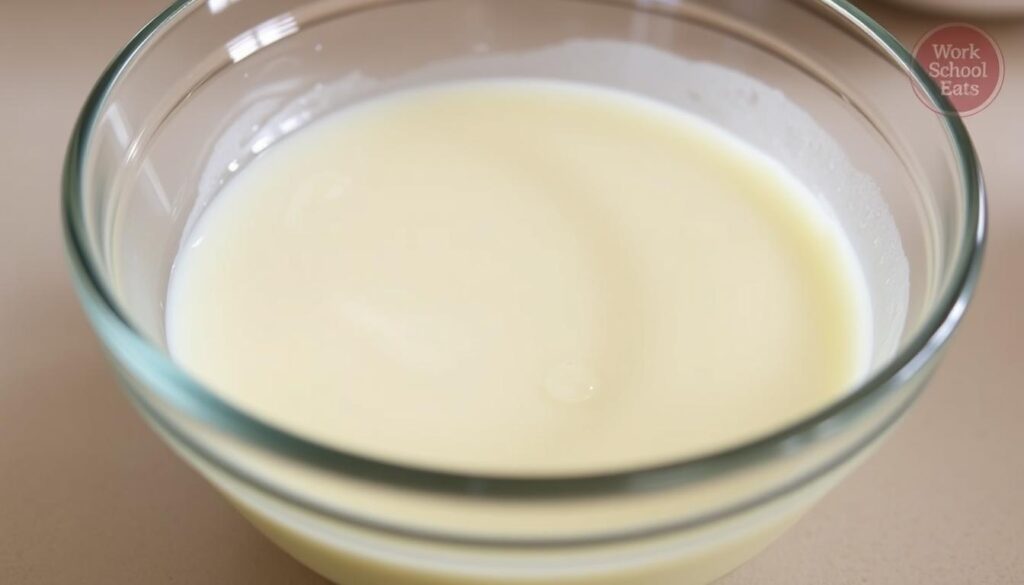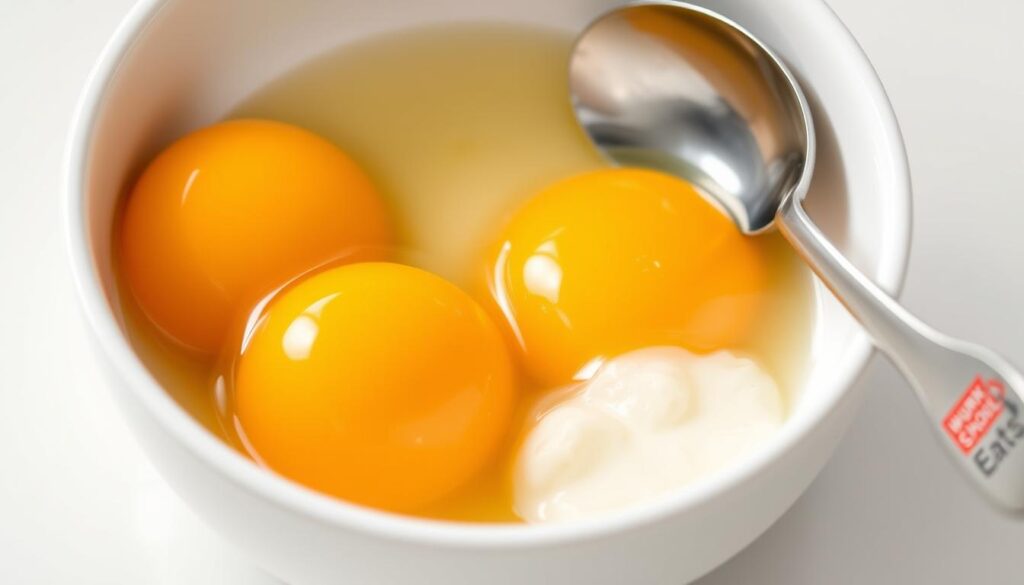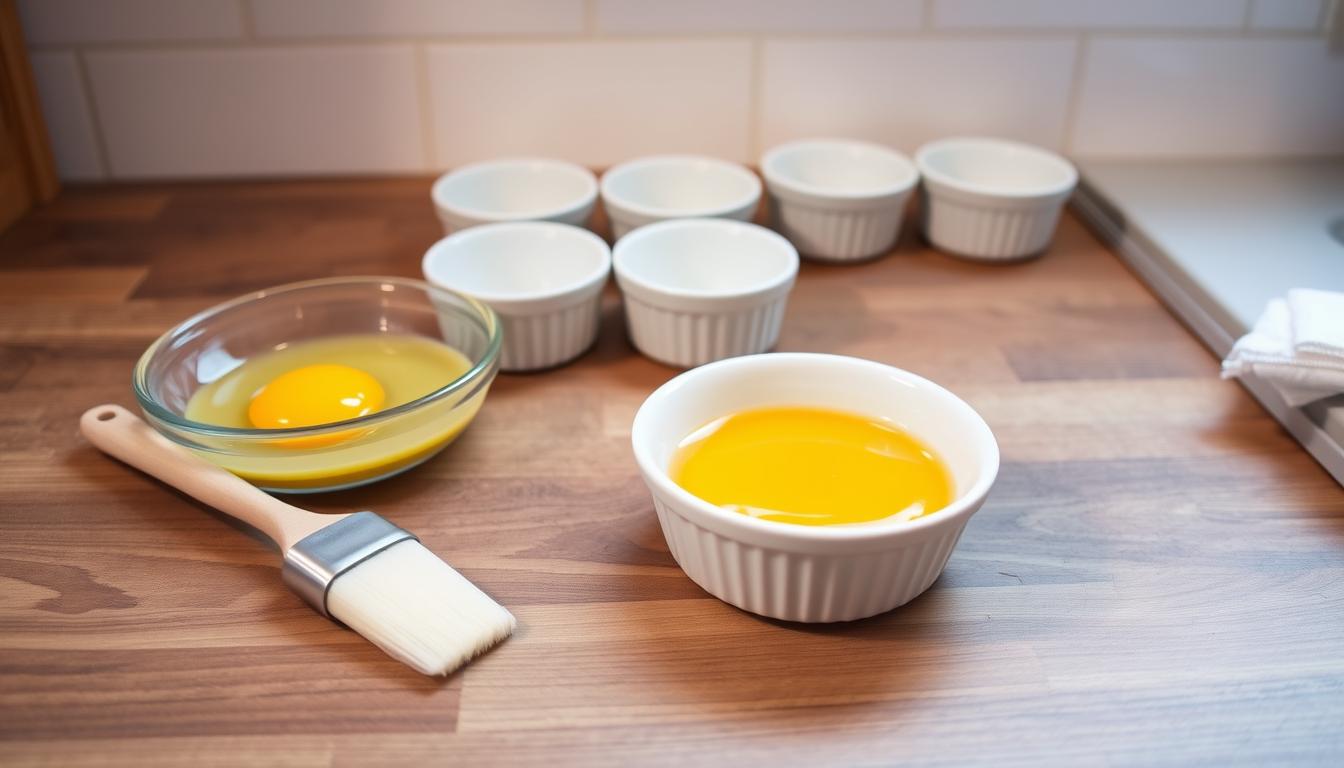Remember the first time you pulled a loaf of homemade bread from the oven, its crust golden and glossy? That magical sheen comes from one simple secret: the egg wash. Whether you’re baking croissants, pastries, or dinner rolls, this humble mix of egg and liquid can transform ordinary dough into something extraordinary. Think of it as nature’s glaze—easy to make yet powerful enough to elevate every bite.
Key Takeaways
- An egg wash adds shine, color, and texture to baked goods like breads and pastries.
- The homemade egg wash recipe requires just two core ingredients: egg and water or milk.
- Trusted sources like Dr. Oetker and NYT Cooking highlight its role in professional and home baking.
- Adjusting the ratio of egg to liquid changes the final finish, from deep golden hues to subtle sheen.
- Mistakes like overapplying can lead to uneven browning—this guide shows how to avoid them.
Table of Contents
Introduction to Egg Wash and Its Uses
Egg wash, a simple mixture of beaten eggs and liquid, plays a vital role in baking. It’s used to create golden glazes on bread, pastries, and pies. This technique enhances both appearance and texture, making it a staple in kitchens worldwide. Whether you’re brushing it onto croissants or basting homemade rolls, understanding egg wash basics unlocks new baking potential.

What is egg wash?
At its core, egg wash combines egg yolks, whites, or whole eggs with water or milk. This mixture acts as a sealant, keeping baked goods moist while promoting a glossy finish. Dr. Oetker’s baking guides explain how the proteins in eggs denature during baking, forming a protective layer. For example, adding a touch of milk creates a richer egg wash for baking, while using only yolks deepens color intensity.
History and evolution of egg wash
- Originated in medieval Europe as a way to preserve breads and pastries
- 18th-century French bakers refined it for croissants and puff pastries
- Modern recipes now incorporate dairy or water variations
“Egg wash is more than a glaze—it’s a bridge between tradition and innovation.”
Today’s cooks adapt this ancient method, whether using it how to make egg wash with store-bought ingredients or exploring plant-based alternatives. From artisanal bakeries to home ovens, its role remains timeless yet endlessly customizable.
Understanding the Egg Wash Recipe Essentials
Creating the perfect easy egg wash starts with mastering its core components. The foundational egg wash ingredients are simple: one egg (or separated yolk/white) combined with a small amount of milk or water. This blend enhances browning, shine, and texture in baked goods without complicating the process.

| Type | Egg Wash Ingredients | Best Use |
|---|---|---|
| Classic | 1 egg + 1 tbsp milk | Pastries, rolls, laminated doughs |
| Light | 1 egg + 2 tbsp water | Bread loaves, brioche, or delicate items |
| Rich | 1 yolk + 1 tsp water | Scones, croissants, or golden glazes |
Adjust ratios based on desired effect: more milk softens texture; water adds translucence. Always whisk ingredients until fully blended to avoid lumps. For easy egg wash success, use room-temperature eggs for smoother mixing. Pro tip: Strain the mixture through a sieve if clumps form.
- Store unused portions in a sealed container up to 2 days
- Use a clean brush or sponge for even application
These basics form the backbone of countless recipes. Experimenting with ratios lets you tailor results to specific dishes without sacrificing simplicity. Whether baking at home or scaling for a kitchen, these essentials guarantee consistent outcomes every time.
Ingredients Spotlight: Egg Wash Ingredients Deep Dive
Unlock the science behind what makes an egg wash work. Whether you’re perfecting a homemade egg wash or seeking alternatives, this section breaks down every component’s role and flexible options.
Homemade Egg Wash Basics
A traditional homemade egg wash uses egg yolks, whole eggs, or whites mixed with liquid. The protein in eggs reacts with heat to create golden browning. Add a splash of milk or water to adjust consistency—thicker for crispier edges, thinner for even coverage. For example, a yolk and milk blend suits croissants, while a whole egg alone works for pretzels.
Exploring Egg Wash Substitutes
Need an egg wash substitute? Experiment with these options:
- Plant-based milk: Almond or oat milk adds moisture and mild flavor
- Butter mixture: Melted butter with water for a non-egg browning agent
- Oil and vinegar: Olive oil mixed with a squeeze of lemon creates a dairy-free option
“A 50/50 mix of apricot preserves can glaze fruit tarts without eggs,” advises pastry chef Michael Torres.
Choose substitutes based on your recipe’s needs. Dairy-free? Try coconut milk. Want extra shine? Opt for butter. Always test a small batch to match your desired outcome.
Step-by-Step Guide on How to Make Egg Wash
Master the egg wash recipe by following these clear instructions. Learning how to make egg wash ensures golden-brown finishes on breads, pastries, or rolls. These steps simplify every stage from prep to application.
Preparing your workspace
Sanitize your counter and tools first. Lay out a bowl, fork or whisk, and a pastry brush. Keep ingredients like egg and milk within reach to avoid spills. A clutter-free space prevents mistakes during mixing.
Mixing the egg wash properly
Follow this simple method for perfect consistency:
- Crack one egg into a bowl and gently beat with a fork.
- Add 1-2 tablespoons of milk or water for desired thickness.
- Whisk until fully blended. Strain if lumps appear.
Applying egg wash for best results
Brush lightly with a clean pastry brush in one direction. Apply before baking to enhance shine without dripping. Let it rest 3-5 minutes for even absorption. Over-brushing can cause soggy edges.
Dr. Oetker’s guidelines recommend brushing in parallel strokes for uniform browning.
Easy Egg Wash Techniques for Baking Success
Mastering the best egg wash starts with technique. For the egg wash for baking, timing and application matter most. Brush gently in one direction to avoid streaks. Let dough rest 10-15 minutes after applying to ensure even absorption.
- Use a clean brush. Dab excess egg wash on a plate before brushing to prevent drips.
- Preheat oven to 375°F. Bake until golden—15-20 minutes for most recipes.
- For extra shine, brush a second coat midway through baking.
A thin, even layer is key to a professional finish. Overbrushing can make pastries soggy. Test on a small piece first.
Adjust technique based on dough type. Over-fermented dough may need less egg wash. Let items cool completely before serving to set the crust. Store unused egg wash in a sealed container up to 2 days. These methods turn homemade bakes into bakery-quality treats.
Tips for Using Best Egg Wash in Your Recipes
Mastering the egg wash technique boosts both taste and presentation. Follow these strategies to elevate your baking with the easy egg wash method.
“A well-applied egg wash is the secret to bakery-quality results at home.” – AllRecipes Baking Guide
Perfecting Texture and Shine
Brush evenly with a soft pastry brush to avoid streaks. For extra shine, let the egg wash dry slightly before baking. Try a egg wash recipe mixed with a splash of milk for smoother spread.
Improving Flavor Profile
- Add a pinch of cinnamon or nutmeg to sweet goods like pastries.
- For savory dishes, mix in garlic powder or paprika.
- Experiment with honey or maple syrup for a caramelized crust.
Common Mistakes to Avoid
| Mistake | Fix |
|---|---|
| Over-brushing | Use light, even strokes to prevent run-off. |
| Incorrect temperature | Bring ingredients to room temperature before mixing. |
| Skipping pre-bake drying | Let the wash set for 5-10 minutes before baking. |
Pair these tips with the easy egg wash method to achieve professional results. Adjust the egg wash recipe to suit your dish’s flavor and texture goals.
Homemade Egg Wash vs. Store-Bought Options
Choosing between a homemade egg wash or a store-bought version comes down to priorities like cost, customization, and quality. While commercial products offer convenience, making your own gives full control over ingredients.
| Aspect | Homemade Egg Wash | Store-Bought Options |
|---|---|---|
| Ingredient Control | Use fresh eggs and milk; adjust ratios to taste | May include additives or preservatives |
| Cost | Affordable with pantry staples | Pricier per use |
| Taste & Quality | Fresher flavor, no artificial additives | Consistent results but less customizable |
| Convenience | Ready in minutes with simple steps | Requires store trips and shelf space |
A homemade egg wash also supports sustainability by reducing plastic packaging waste. For those avoiding eggs, consider a egg wash substitute like aquafaba or yogurt—easily mixed at home. Chefs often prefer homemade for its freshness, ensuring baked goods have that golden-brown sheen without mystery ingredients.
Creative Uses of Egg Wash in Cooking and Baking
Take your cooking to new heights by exploring how egg wash ingredients transform everyday dishes. Beyond basic breads and pastries, this simple mixture unlocks unexpected flavors and textures.
Enhancing Pastries
Brush croissants or Danish pastries with a best egg wash mixed with sugar for a golden sparkle. Top chefs like those at Parisian patisseries use this trick to create crackled surfaces on tarts or streusel toppings.
Baking Breads with Egg Wash
For artisan sourdough, a diluted egg wash (egg yolk + water) creates a glossy crust. Pretzel shops often add baking soda to their mixture for that signature dark finish. Experiment with spices like cayenne or paprika for savory bread color and taste.
Unique Culinary Applications
- Brush empanadas before baking for a sealed, crunchy edge
- Use as a binder in stuffed ravioli or dumplings
- Add citrus zest to the egg wash for a tangy glaze on roasted vegetables
| Application | Egg Wash Variation | Result |
|---|---|---|
| Pastries | Egg + milk (1:1) | Shiny, uniform finish |
| Breads | Yolk only | Deep golden crust |
| Savory dishes | Egg + garlic powder | Umami-rich coating |
Professional bakers at New York’s Balthazar use an egg wash ingredients combo of egg white and cream for delicate macarons. Whether you’re making breakfast rolls or gluten-free flatbreads, the best egg wash adapts to any kitchen adventure.
Egg Wash Recipe Variations for Different Dishes
Experiment with egg wash recipe twists to match any dish’s flavor or style. From savory upgrades to sweet additions, these easy tweaks add depth without complexity.
“A simple egg wash becomes transformative when paired with the right ingredients.” – Chef Julia Child, culinary innovator
Savory Alternatives
Boost umami flavors by mixing egg with garlic-infused oil or grated Parmesan. Try these options:
- Garlic and herb blend: whisk minced garlic into the egg
- Salt-enhanced: add a pinch of sea salt
- Asian-inspired: stir in soy sauce or sesame oil
Sweet Ingredients Twist
Create easy egg wash sweetness with vanilla extract, cinnamon, or citrus zest. For example:
- Vanilla-infused: mix ½ tsp vanilla extract
- Citrus zing: add lemon or orange zest
- Cinnamon swirl: sprinkle ground cinnamon before brushing
Global Adaptations
Global cuisines inspire unique takes:
- Japanese: combine with milk for brioche
- Mexican: add chili powder for crusty tortillas
- Indian: mix with ghee for naan breads
These egg wash recipe ideas work with any baking project. Adjust ingredients to match your menu’s theme—creativity is key!
How to Achieve the Right Consistency in Your Egg Wash
Getting the right consistency is key to perfect egg wash for baking. A mixture that’s too thick won’t spread evenly, while a runny one might drip off your dough. Here’s how to balance it:
- Mix 1 egg with 1-2 tablespoons of water or milk. This ratio works for most recipes, but adjust based on your dough’s absorbency.
- Test the mix by dipping a brush. It should cling to the brush without dripping. If it’s too thick, add a splash of water. Too thin? Add another yolk.
- Whisk until smooth. Lumps can create uneven spots, so mix until fully combined.
Professional bakers often brush a small amount on scrap dough first to check results. If the mixture soaks in too quickly, add more liquid. If it sits on top, mix in another egg yolk for richness. Avoid overmixing, as this creates froth that can leave bubbles on baked goods. For how to make egg wash with precision, always start with the basic ratio and tweak gradually. Remember, consistency varies by recipe—savory breads might need thinner mixes, while pastries often require thicker coatings. Practice these steps to ensure your egg wash for baking enhances texture and shine every time.
Mastering the Egg Wash Recipe for Perfection
Perfecting your egg wash recipe starts with precision. Small adjustments in measurements and timing turn a standard egg wash into the best egg wash for your baked goods. Follow these steps to ensure consistent results every time.
Ingredient measurements
Exact ratios matter. Use this table to match ingredients to your recipe:
| Purpose | Egg | Liquid | Notes |
|---|---|---|---|
| Pastries | 1 large egg | 1 tbsp water | Adds golden shine |
| Bread | 1 egg | 2 tbsp milk | Softens crust texture |
| Savory items | 1 egg | 1 tbsp water + pinch salt | Enhances savory flavor |
Timing and techniques
- Mix eggs and liquid for 20 seconds—no longer—to avoid air bubbles.
- Apply brush strokes just before baking starts to lock in moisture.
- Bake at 375°F (190°C) for 15-20 minutes for optimal browning.
Finishing touches
- Brush in one direction for even coverage.
- Let baked goods rest 5 minutes before glazing for better adhesion.
- Experiment with a second coat halfway through baking for deeper color.
Conclusion
A homemade egg wash is more than a simple mix—it’s a tool to elevate both flavor and appearance in baking. By mastering its preparation, you ensure golden crusts on bread or glossy pie edges every time. Whether using a traditional egg and water blend or an egg wash substitute like milk and cornstarch, adaptability is key.
Remember to adjust ratios for desired texture and always apply the wash just before baking. Experimenting with variations like honey or spices adds unique twists to classic recipes. These techniques turn ordinary dishes into showstoppers, whether you’re making breakfast pastries or holiday desserts.
Exploring homemade egg wash methods builds confidence in the kitchen. Whether you’re substituting ingredients for dietary needs or perfecting a family recipe, this versatile step deserves attention. Applying these tips ensures your creations shine, proving even small details make a big impact.

